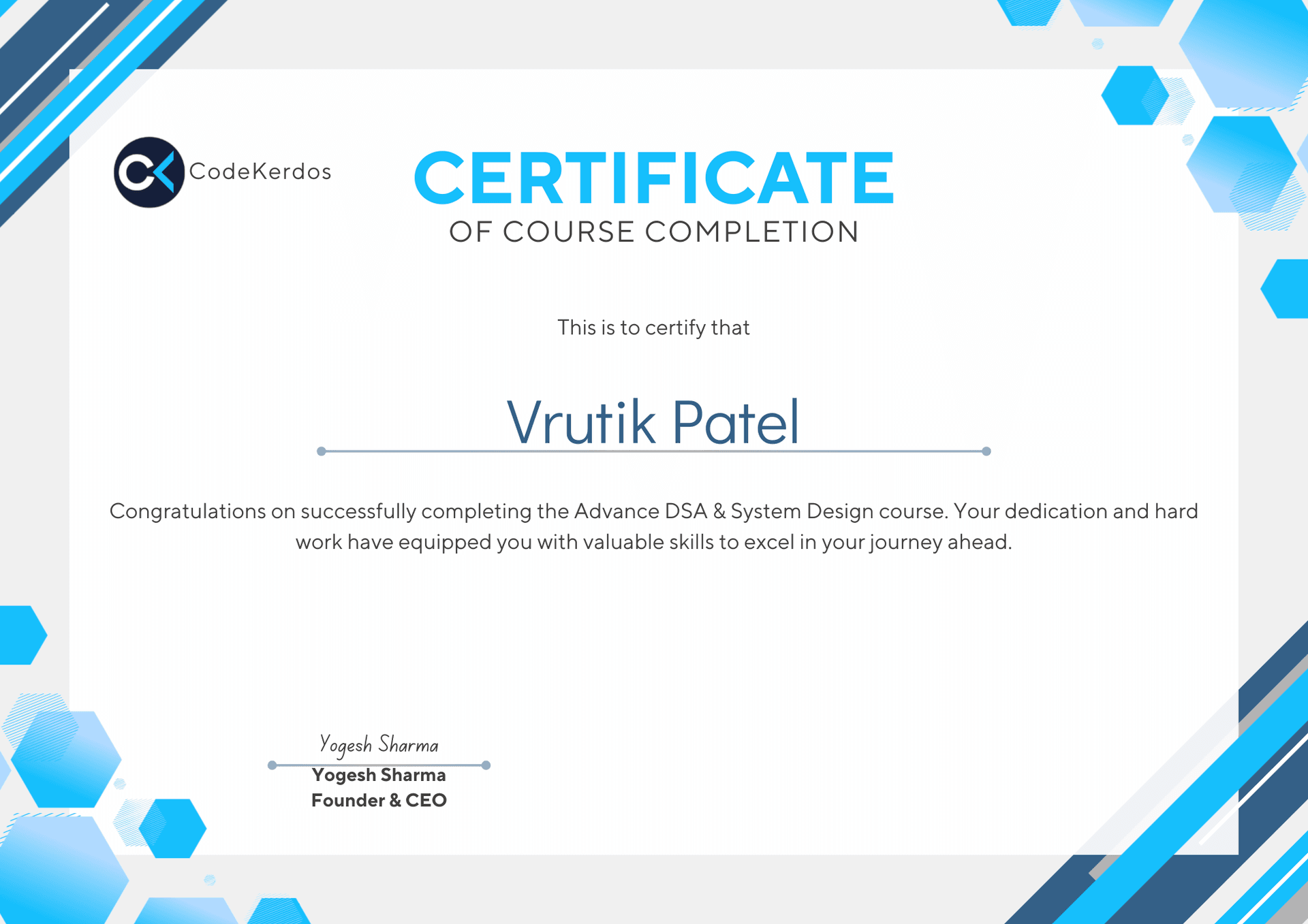Join Advance DSA + System Design to strengthen your problem-solving expertise and master scalable architecture! Sharpen your skills in algorithms, data structures, and high-level design patterns, learn to tackle complex coding challenges, and build system designs inspired by real-world tech giants — all while exploring how AI-driven problem solving and optimization are reshaping modern software engineering.
Saksham Arora
Advance
Algorithmic Mastery
Interview Preparation
AI-Enhanced Problem Solving
Structured Learning Path
System Design Excellence
Real-World Case Studies
Mentorship Support
Confidence to Compete
Software Engineering
Data & Infrastructure
Startups & Scale-Ups
AI & Optimization Roles
Big Tech & Product Companies
Enterprise IT & Consulting
Competitive Programming & Research
Freelancing & Remote Work
Advance DSA + System Design is your gateway to becoming a problem-solving expert and system architect. This comprehensive program takes you from the foundations of data structures and algorithms to mastering high-level design principles for building scalable, reliable, and efficient systems.
You'll start by strengthening your DSA fundamentals and tackling complex algorithmic challenges, then move on to system design patterns — from designing APIs and databases to building architectures inspired by real-world products like Netflix, Uber, and Amazon. Along the way, you'll also learn how to leverage AI tools for coding practice, optimization, and even AI-powered mock interview simulations to accelerate your preparation.
Through hands-on coding problems, real-world case studies, and expert mentorship, you'll develop the ability to approach technical interviews with confidence and design systems that can scale to millions of users.
By the end of the course, you'll have the problem-solving depth, architectural mindset, and interview-ready confidence to excel as a Software Engineer, Backend Developer, System Designer, Solution Architect, or Performance Engineer across big tech, startups, and enterprise IT.
With a structured curriculum, industry-relevant case studies, and career-focused guidance, Advance DSA + System Design is designed to make you job-ready for top product companies and future-proof your career in the evolving world of AI-driven software engineering.


Before joining CodeKerdos, I was looking for a structured path to strengthen my problem-solving and system design skills. The Advanced DSA + System Design program helped me think differently, approach problems strategically, and gain deep clarity on concepts that are critical for top-tier interviews. The structured curriculum, real-world case studies, and personalized mentorship prepared me step by step for challenges I would face in interviews. The mock interview sessions and continuous feedback gave me the confidence to perform at my best.
With this guidance and support, I achieved my dream of getting placed at Microsoft. I am truly grateful for the journey, the mentors, and the community at CodeKerdos that made it possible.
The project adheres to a comprehensive 7-step framework, which includes: defining requirements, developing APIs, estimating resources, modeling data, creating a high-level design, detailing components, and addressing bottlenecks and scaling.
This case study explores Twitter's high-level design. It investigates how to handle high read/write throughput, optimize feed generation, manage notifications and address challenges like hashtag management. It emphasizes on designing a core system, managing data, and developing a strong caching strategy.
This case study explores the high-level design of Instagram. It investigates how to handle petabytes of data, scaling image and video storage, designing news feeds and timelines, and optimizing user engagement. It emphasizes on designing core systems, storing media, and developing a strong caching strategy.
This case study explores the high-level design of a popular messaging platform that facilitates real-time communication. It investigates how to handle message delivery across diverse devices, this challenges addressed include offline message handling, media file transmission, and a user system powered by reliable offline storage for users.
This case study examines digital collaboration platforms like Slack and Discord. It investigates how to handle real-time messaging, how to include scaling live chat systems and building a solid data model. It emphasizes on a reliable under heavy loads.
This case study covers the end-to-end video platform design. It investigates how to handle a large number of video recommendations. It emphasizes challenges like video encoding, data transfer, and optimization of video streaming along with millions of queries.
This case study investigates personalized content delivery through a subscription plan. It emphasizes on data management, high availability, ensuring smooth streaming across devices and geo-distributed delivery on a global scale.
Discover all the essential information about our courses in our detailed brochure. Get insights on curriculum, schedules, and enrollment options to help you make the best choice for your education.
Join Advance DSA + System Design to enhance your problem-solving skills and master scalable architecture! Improve your expertise in algorithms, data structures, and design patterns, tackle complex coding challenges, and create system designs inspired by tech giants, all while discovering how AI is transforming software engineering.
Flexible monthly EMI plans available for up to 24 months.
Explore the various modes of payment available today: UPI for instant transfers, cards for secure transactions, wallets for convenience, and net banking for easy online management. Each option offers unique benefits to suit your needs.
Final pricing refers to the last and definitive cost of a product or service, including all applicable fees and discounts.
Includes: